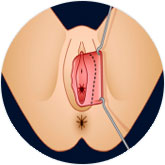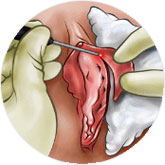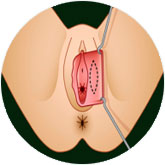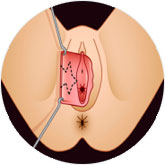
When performed properly, labiaplasty (labia minora reduction) results in very high satisfaction. Partial resection and V plasty are the most common labiaplasty techniques.
When performed properly, labiaplasty is a genital cosmetic procedure with high patient satisfaction rates. It required a complete preoperative planning. It can be performed with different techniques based on the patient's tissue and her expectations from the surgery.
Although many other similar methods have been defined, partial resection and V plasty techniques are the most preferred ones.
Partial resection is the technique more commonly preferred by patients with wrinkled and excessively wide labia minora. In this technique, the excess skin parts can be removed in line with the request of the patient.
 Partial Resection
Partial Resection
It is a relatively easier technique that has also a very fast recovery process. It is the most preferred labiaplasty technique in our clinic. Curvilinear partial resection is the most ideal labiaplasty technique especially for patients who desire the Eserdag Barbie vaginal appearance. The incision in the partial resection technique should be slightly elliptical, not straight.
Eserdag Barbie Vagina Concept
Most of patients who consider labiaplasty desire to keep the labia minora as short as possible.
Labiaplasty with partial resection is the most suitable surgical technique especially for patients who want their labia minora to be as minimal as possible, in the form of ‘Barbie doll vagina’. This term coined by Los Angeles high society has quickly spread around the world. After bringing this concept to our country for the first time, we carried out some studies on achieving "the most attractive appearance" by adding some extra features. Thus, the concept of Eserdag Barbie Vagina was born.
The Eserdag Barbie vagina concept of includes certain features such as reducing the labia minora as much as possible, reducing the upper clitoral tissue as much as possible with the Y plasty technique with intent to remain no excess part that hangs out while the woman stands with legs together, and providing the appearance of the thin sexy line called the ‘cleft of venus’. When necessary, labia majora can be made fuller and more attractive with the fat grafting technique using the fat tissue taken from the abdomen or inner parts of the legs. After the rejuvenation, the genital area looks15-20 years younger.
It is a technique used to reduce the labia minora by making a V-shaped incision. In a labiaplasty operation performed with V plasty, the natural edges of the labia minora are preserved. As a result, it will not be noticeable that the patient has have labiaplasty.
However, if the outer part of the labia minora is very rough and excessively dark colored, partial resection technique will be more suitable than the V plasty labiaplasty.
Labiaplasty with the V plasty technique is more suitable for patients with only labial asymmetry, patients with regular lip contours, and patients with not thick labia. In addition, the width of the labia minora must be at least 4 cm. Labiaplasty operations performed with the V plasty technique involve the risk of fenestration (the tissue looks like perforated leather) due to wound dehiscence in the labia minora, if there is too much tension in the tissue. It should be performed by experienced physicians.
Wedge Resection, one of the surgical techniques of labiaplasty, can be performed with ‘wedge’ shaped tissue removal from the labia minora. The incision site is determined based on the condition of the labial artery.
The aim is to minimize bleeding during labiaplasty operations. Wedge resection in labiaplasty (wedge-shaped tissue removal from the labia minora) can be performed from the lower, middle or upper segments.
 Laser Labiaplasty
Laser Labiaplasty
It is a kind of labiaplasty performed by making incision usually with CO2 (carbon dioxide) laser. The advantage of laser labiaplasty is that it allows for less bleeding. It is suitable for patients with thick labia minora in particular. During laser labiaplasty, bleeding is minimal thanks to the thermal (heat-transmitting) effect of the laser, and usually a small number of sutures are placed.
Based on my own observations, I can say that laser incision should not be preferred because of its destructive effects on the tissue and longer the wound healing process.
Making a 'clear incision' (incision with a lancet or scissors) is a more appropriate technique. However, laser labiaplasty can be appropriate for patients at a higher risk of bleeding.
In laser labiaplasty, generally carbon dioxide (CO2) laser is used. Incisions are made using laser with a power level of 10 to 15 watts on average.
 Delamination
Delamination
The deepitelization (delamination) is a labia minora reduction technique performed by removing tissue from the inner and outer parts, without making a complete incision on the labia minora. Its new name is the 'delamination technique'.
The aim is to preserve the nerves and blood vessels in the labial structure.
Labiaplasty operations performed with the deepitelization technique involve the risk of scarring (scar tissue) and swelling in the labial structure.
Therefore, it is not commonly preferred. In addition, they involve only vertical reduction of the labia minora, that is, not involve lateral reduction.
 Star Labioplasti
Star Labioplasti
There are also some other labiaplasty techniques defined by some otors in the literature, such as Z plasty, Superior pedicle reconstruction, inferior wedge resection and Star labiaplasty.
These techniques are quite rarely used.
There are a variety of other labiaplasty techniques defined in the literature, but they are rarely preferred.
In choosing the surgical technique for labiaplasty, it is important to determine whether the natural edges of the labia minora will be preserved. Some patients want the natural edges to be preserved, while most patients request the removal of the edges as well as elimination of the dark colored areas and wrinkles. This completely depends on the patient's request.
IMPORTANT NOTE: Clitoral hood reduction is also required for most of the patients who will have labiaplasty. If the labia minora is highly reduced and the clitoral hood is left untouched, the operation results in a worse appearance.
‘What is the best technique in labiaplasty? What path should I follow?' There is no clear answer to these questions frequently asked by patients. When choosing the labiaplasty technique, the decision should be made considering the condition of the patient's tissue and her expectations from the surgery. Besides seeing labiaplasty before-and-after photos, watching labiaplasty surgery videos can be intimidating for some patients, but can be instructive for some others. No matter what technique labioplasty operation is performed, it is extremely important make sure that the physician who will perform the surgery has surgical experience and knows the anatomy of the region well.
Incorrect implementation of the technique may cause complications, and consequently, there may be a need for labiaplasty revision surgery in the future. Therefore, it is of great importance to make a good decision and plan the correct technique at the beginning.
Techniques like laser and radiofrequency sound miraculous, don't they? People mostly think that the tissues are cut with lightsabers and then the wounds heal on their own. However, the truth is a little bit different from what you might think...
Labiaplasty means the surgical reduction of the labia minora performed in such a way as to make the both labia symmetrical. So, labiaplasty is a surgical procedure. It is not possible to reduce an existing tissue without cutting it. Non-surgical solutions are possible only in procedures intended to narrow hollow organs such as the vagina.
As explained above, non-surgical labiaplasty is not possible. When cutting the labia, i.e. the inner genital lips, technological devices such as laser device or radiofrequency device can also be used beside surgical scissors. Each technique has its own advantages and disadvantages. The important thing is that you should believe your surgeon will choose the right technique for you.